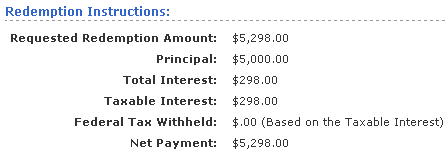 The new fixed rate for Series I Savings Bonds (“I Bonds”) was announced on Monday to be 0.7%. A few readers asked if I thought this was a good time to buy.
The new fixed rate for Series I Savings Bonds (“I Bonds”) was announced on Monday to be 0.7%. A few readers asked if I thought this was a good time to buy.
As a long-term investment, a 0.7% real yield makes I-Bonds a poor choice, as you can buy TIPS with much better yields. As of yesterday, a 5-year TIPS had a 3.66% real yield.
As a short-term investment, it depends on how you think inflation will turn out in the near future.
If you buy now in November, you will earn 0.7% fixed + 4.94% based on inflation = 5.64% for the first 6 months. The second 6-month rate will be 0.7% + a variable rate based on inflation from September 2008 to March 2009. So far, the markets seem to suggest that there is a decent possibility that there might even be deflation for this period. Reminders: You must hold for at least a year (or 11 months and a day if you buy on the last day of the month). If you hold for less than 5 years, there is a penalty of the last 3-months interest.
Worst case scenario, there is deflation of worse than 0.7% which makes the total rate zero for the 2nd six months. Earning 5.64% for 6 months with an 11-month holding period gives you only an effective 3.07% APY. If say, inflation is 1%, you’d get an effective 3.54% APY for the minimum 11-month hold. Even if this is exempt from state taxes, the tax-equivalent yield won’t be far above 4%. You can do better with bank CDs.
The only scenario where I-Bonds may be better than what you can get from a bank is if you think annualized inflation will be higher than 1.5% over the next 6 months. Personally, combined with the lack of short-term liquidity, I don’t think I’d take that bet right now.
For more background, see my last post on savings bonds.

 If you earned any interest from Treasury Bills or Savings Bonds last year, and are subject to local or state income taxes, be sure note it on your tax returns! Interest from federal debt obligations such as these are subject to federal tax, but not state or local income taxes. Here are some tips and examples to make sure you file correctly and get all the money that’s owed to you.
If you earned any interest from Treasury Bills or Savings Bonds last year, and are subject to local or state income taxes, be sure note it on your tax returns! Interest from federal debt obligations such as these are subject to federal tax, but not state or local income taxes. Here are some tips and examples to make sure you file correctly and get all the money that’s owed to you.
 The Best Credit Card Bonus Offers – 2025
The Best Credit Card Bonus Offers – 2025 Big List of Free Stocks from Brokerage Apps
Big List of Free Stocks from Brokerage Apps Best Interest Rates on Cash - 2025
Best Interest Rates on Cash - 2025 Free Credit Scores x 3 + Free Credit Monitoring
Free Credit Scores x 3 + Free Credit Monitoring Best No Fee 0% APR Balance Transfer Offers
Best No Fee 0% APR Balance Transfer Offers Little-Known Cellular Data Plans That Can Save Big Money
Little-Known Cellular Data Plans That Can Save Big Money How To Haggle Your Cable or Direct TV Bill
How To Haggle Your Cable or Direct TV Bill Big List of Free Consumer Data Reports (Credit, Rent, Work)
Big List of Free Consumer Data Reports (Credit, Rent, Work)